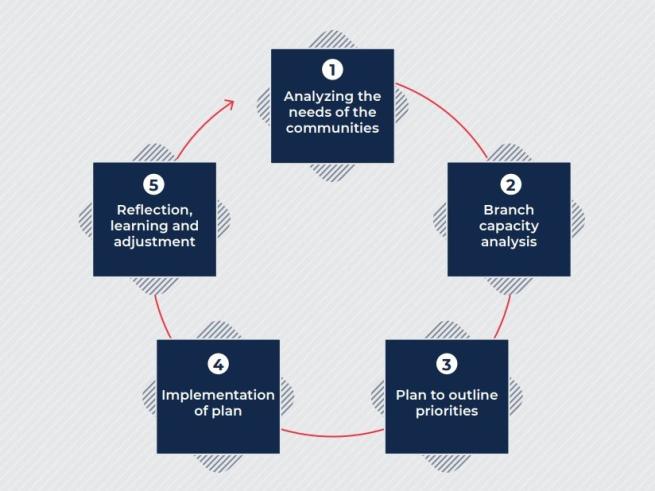This section describes a sample branch development process. It is presented in a linear format but branch development is not a linear process; it is complex and messy. There are many potential triggers for branch development and the process will evolve in unexpected ways. For example improving your branch's election or volunteer induction processes, or through more significant changes, such as diversifying your volunteer base or scaling up your team, resources, systems and processes to lead a large disaster response operation. The only thing we can be sure of is that you cannot plan for its many surprises and unexpected challenges.
Involves analysing the needs of the communities that the branch serves. This information may already be available to the branch or the branch may have to undertake a needs assessment, or update an existing assessment.
Involves undertaking an assessment and analysis of the branch's capacities and areas for development and based on this determining where the branch can have the most impact in addressing local needs.
The Branch Organisational Capacity Assessment (BOCA), which is a self-assessment tool developed for branches to identify and assess their strengths, limitations and challenges in relation to a wide range of organizational capacities, can be used as the first step in a branch development process.
Once the branch has undertaken an external and internal assessment it can develop a plan of action that outlines how it will achieve its priorities. The plan will cover both the activities that the branch intends to implement in communities as well as any internal work that is required to develop the competencies of the branch.
At the National Headquarter level, some National Societies consolidate the outcomes from the branches’ capacity assessment, conduct a national wide analysis and include collective priorities in its national plans such as Strategic Plans or National Society Development plans.
This is the implementation of the plan. The plan may need to be adjusted to adapt to changing conditions as they emerge, with the branch switching between pre-planned actions and adaptive responses along the way.
In some cases, the National Headquarter support branches by facilitating peer-support or link to information and knowledge to enable branches to implement its plans.
This involves reviewing the status of the branch's work against its plan, what has been achieved, what has been learned and what needs to be adjusted or adapted for the next cycle of development.
This video provides further example on how Ukraine Red Cross Society conducted Branch Development in thier context
